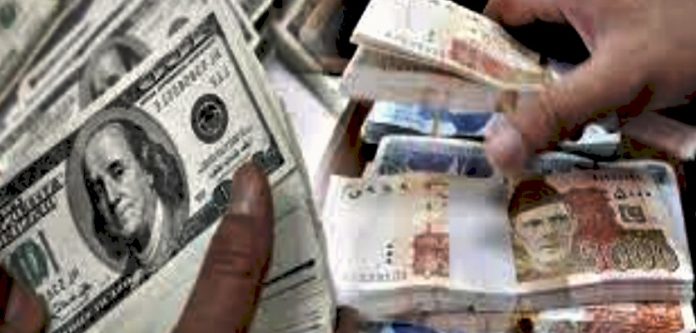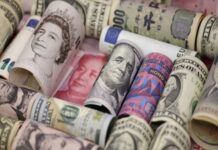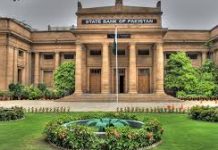
LAHORE: The rupee on Monday depreciated to a record low of Rs121 against the US dollar in the inter-bank market, as worries persist over Pakistan’s worsening macroeconomic indicators.
An official press release issued by the central bank said “Today, the PKR-US$ exchange rate in the interbank market closed at PKR 119.84 per US$ while witnessing an intraday low and high of PKR 117.00 and PKR 121.50 per US$ respectively. This movement is based on foreign exchange demand-supply gap in the interbank market.”
The State Bank of Pakistan added “The market-based adjustment is reflective of the country’s external Balance of Payments position which is under pressure due to a large trade deficit. Despite the continued growth in exports (13.3 percent in Jul-Apr FY18) and some uptick in remittances, growing imports have pushed the current account deficit to US$ 14.0 billion during the first ten months of FY18, which is 1.5 times the level of deficit realized during the same period last year.”
The central bank believed “this market-driven adjustment in the exchange rate along with other recent policy measures are expected to contain the imbalances in the external account thereby containing aggregate demand and also facilitate the prospects for generating non-debt creating inflows.”
According to Topline Security, rupee devalued by 3 to 4 percent in early hours of the interbank market today between Rs119-120.
It reportedly went as high as Rs122 (4.6 percent) and then came back down to Rs119-120 as per sources. To recall, Friday’s close was Rs115.62.
The dollar which was previously trading at Rs115.63 in the inter-bank market, rose by Rs5.38, as per foreign exchange dealers on Monday.
The rupee was being traded at Rs124 against the greenback in the kerb market on Monday.
In a comment to Profit, Maha Jafer Butt Director Research Capital Stake said, “Today’s fall takes the rupee down around 13 percent to the dollar. The fall isn’t a surprise to market participants who thought it to be a necessity. The move comes as a possible measure to combat the growing current account and trade deficits.”
“The declining reserves, foreign reserves now at three year low, made it hard to maintain currency level. The rise in international crude oil prices has made matters worse.
The greenback has been in short supply since the commencement of Ramazan.
The State Bank of Pakistan’s (SBP) decision to introduce identification requirements for all foreign currency buy and sell transactions equivalent to $500 or above on exchange companies and directed them to retain the copies of identification documents to comply with anti-money laundering rules has contributed to a slow down in the flow of dollars to the dealers.
On June 1st, the rupee plunged to a then-record low of Rs119.35 in the kerb market against the US dollar, as dwindling foreign exchange reserves continued to impact the local currency.
A low inflow of dollars from overseas Pakistani’s and dipping forex reserves had increased demand and prices in the kerb market since the commencement of Ramazan.
Many expecting an imminent devaluation of the rupee had started hoarding their dollars foreseeing a better return later.
It would be the third time that rupee has been devalued during the current financial year. The government had devalued the rupee by around 5 percent on Dec 8th, 2017 to Rs110 and then again by around 4.5 percent to Rs115 on Mar 20, 2018.
In the last decade, the rupee has devalued annually by around 5 percent.
Previously, credit rating agency Moody’s in May projected the rupee could plunge by 7.75 percent and touch Rs125 to the dollar by June 2019.
Also, Pakistan’s current account deficit touched a record high of $14.03 billion during the first ten months (July-April) of FY18, widening by 50 percent.
Increase in current account deficit impacts foreign exchange reserves and the country’s external debt and liabilities touched a record high of $91.8 billion by end of March 2018, according to an SBP report last month.
This figure of $91.8 billion for external debt and liabilities is 50.6 percent higher or increased by $30.9 billion compared to June 2013 when the PML-N took reins of the government.
In mid-April, while visiting Washington for IMF’s spring meeting’s, former finance minister Dr Miftah Ismail in an interview to Bloomberg TV said rupee had attained its “optimal value” and wouldn’t require further devaluation.
IMF’s post programme report released in March had welcomed the central bank’s decision to allow the rupee to depreciate against the dollar in early-December 2017, but emphasized on the significance of greater exchange rate flexibility on a more permanent basis to enhance competitiveness and safeguard external buffers.
The IMF report added “staff advised to unwind the increased government borrowing from the SBP, which would support monetary tightening. Going forward, greater exchange rate flexibility will need to be accompanied by a further adjustment of the policy stance as well as a strengthening of the interest rate-based monetary policy framework with appropriate intermediate and operational monetary policy targets, and a clear limit to FX interventions.”
A United Nations report in December last year had warned Pakistan’s policy of keeping the rupee stable could become untenable if the US dollar appreciated against other world currencies and could possibly erode the country’s foreign exchange reserves.






